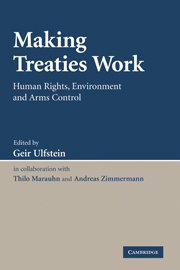Book contents
- Frontmatter
- Contents
- Preface and acknowledgments
- Notes on the contributors
- Table of cases
- Table of treaties and other international instruments
- INTRODUCTION
- PART I INTERNATIONAL HUMAN RIGHTS
- PART II INTERNATIONAL ENVIRONMENTAL LAW
- 5 Dispute resolution, compliance control and enforcement in international environmental law
- 6 The Convention on International Trade in Endangered Species of Wild Fauna and Flora (CITES)
- 7 The Convention on Long-Range Transboundary Air Pollution
- 8 The Convention on Access to Information, Public Participation in Decision-Making and Access to Justice in Environmental Matters (Aarhus Convention)
- 9 The Convention on Environmental Impact Assessment in a Transboundary Context (Espoo Convention)
- PART III INTERNATIONAL ARMS CONTROL
- GENERAL COMMENTS
- Index
9 - The Convention on Environmental Impact Assessment in a Transboundary Context (Espoo Convention)
Published online by Cambridge University Press: 05 September 2009
- Frontmatter
- Contents
- Preface and acknowledgments
- Notes on the contributors
- Table of cases
- Table of treaties and other international instruments
- INTRODUCTION
- PART I INTERNATIONAL HUMAN RIGHTS
- PART II INTERNATIONAL ENVIRONMENTAL LAW
- 5 Dispute resolution, compliance control and enforcement in international environmental law
- 6 The Convention on International Trade in Endangered Species of Wild Fauna and Flora (CITES)
- 7 The Convention on Long-Range Transboundary Air Pollution
- 8 The Convention on Access to Information, Public Participation in Decision-Making and Access to Justice in Environmental Matters (Aarhus Convention)
- 9 The Convention on Environmental Impact Assessment in a Transboundary Context (Espoo Convention)
- PART III INTERNATIONAL ARMS CONTROL
- GENERAL COMMENTS
- Index
Summary
The 1991 Convention on Environmental Impact Assessment in a Transboundary Context (the Espoo Convention) was negotiated under the auspices of the United Nations Economic Commission for Europe (ECE) and was signed in Espoo, Finland, in 1991. Following six meetings of the signatories, the Convention entered into force in 1997 and the first Meeting of the Parties (MoP) took place in Oslo in 1998. The Strategic Environmental Assessment (SEA) Protocol to the Convention was adopted in 2003, and has been signed by thirty-six States as well as by the EC.
The institutional development within the Espoo regime has progressed over time. The Meeting of the Parties, representing the voice of States parties, has taken place three times, and has adopted many important decisions pertaining to the institutional structure of the Espoo Convention. The Bureau of the Convention was established as an organ to co-ordinate the work pertaining to the development of the system of the Convention between the Meetings of the Parties. Secretariat tasks are handled by the ECE. The MoP is now assisted by the Working Group on Environmental Impact Assessment (EIA) and the Implementation Committee. The Working Group on EIA assists the MoP in the implementation of the Convention and the management of the work-plan, and the Implementation Committee has the dual task of developing the reporting system and considering individual cases of non-compliance.
- Type
- Chapter
- Information
- Making Treaties WorkHuman Rights, Environment and Arms Control, pp. 218 - 240Publisher: Cambridge University PressPrint publication year: 2007
- 2
- Cited by



